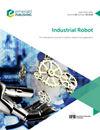基于修正轨迹规划的协同机器人振动抑制
IF 2.5
4区 计算机科学
Q3 ENGINEERING, INDUSTRIAL
Industrial Robot-The International Journal of Robotics Research and Application
Pub Date : 2022-05-31
DOI:10.1108/ir-01-2022-0017
引用次数: 1
摘要
本文旨在减少机器人在工作过程中的低频共振和残余振动,提高工作精度和效率。减轻重量和提高负载重量比可以提高协作机器人的实际应用。然而,由于重量减轻和负载重量比大带来的灵活性,导致机器人在运行过程中产生低频共振和残余振动,降低了工作精度和效率。采用改进的轨迹规划方法抑制协同机器人的振动。采用有限元法和拉格朗日法建立了协作机器人的刚柔耦合动力学模型,推导了机器人的振动方程。以激振力为优化目标进行轨迹规划,并对轨迹规划方法进行改进,以减小协同机器人的振动,保证机器人末端的精度。研究结果:振动幅度减小80%。抑制振动前关节的最大扭矩幅值达到50 N·m。抑制振动后,接头最大扭矩幅值为10 N·m,运行过程中消除了谐振现象。验证了改进的轨迹规划方法的有效性,显著降低了协作机器人运动中的振动和残余振动,提高了机器人的定位精度和工作效率。独创性/价值该方法可以大大降低协作机器人的振动和残余振动,提高定位精度和工作效率,促进协作机器人在工业和服务领域的快速应用和发展。本文章由计算机程序翻译,如有差异,请以英文原文为准。
Vibration suppression of collaborative robot based on modified trajectory planning
Purpose
The paper aims to reduce the low-frequency resonance and residual vibration of the robot during the operation, improve the working accuracy and efficiency. A reduced weight and large load-to-weight ratio can improve the practical application of a collaborative robot. However, flexibility caused by the reduced weight and large load-to-weight ratio leads to low-frequency resonance and residual vibration during the operation of the robot, which reduces the working accuracy and efficiency. The vibrations of the collaborative robot are suppressed using a modified trajectory-planning method.
Design/methodology/approach
A rigid-flexible coupling dynamics model of the collaborative robot is established using the finite element and Lagrange methods, and the vibration equation of the robot is derived. Trajectory planning is performed with the excitation force as the optimization objective, and the trajectory planning method is modified to reduce the vibration of the collaborative robot and ensure the precision of the robot terminal.
Findings
The vibration amplitude is reduced by 80%. The maximum torque amplitude of the joint before the vibration suppression reaches 50 N·m. After vibration suppression, the maximum torque amplitude of the joint is 10 N·m, and the resonance phenomenon is eliminated during the operation process. Consequently, the effectiveness of the modified trajectory planning method is verified, where the vibration and residual vibration in the movement of the collaborative robot are significantly reduced, and the positioning accuracy and working efficiency of the robot are improved.
Originality/value
This method can greatly reduce the vibration and residual vibration of the collaborative robot, improve the positioning accuracy and work efficiency and promote the rapid application and development of collaborative robots in the industrial and service fields.
求助全文
通过发布文献求助,成功后即可免费获取论文全文。
去求助
来源期刊
CiteScore
4.50
自引率
16.70%
发文量
86
审稿时长
5.7 months
期刊介绍:
Industrial Robot publishes peer reviewed research articles, technology reviews and specially commissioned case studies. Each issue includes high quality content covering all aspects of robotic technology, and reflecting the most interesting and strategically important research and development activities from around the world.
The journal’s policy of not publishing work that has only been tested in simulation means that only the very best and most practical research articles are included. This ensures that the material that is published has real relevance and value for commercial manufacturing and research organizations. Industrial Robot''s coverage includes, but is not restricted to:
Automatic assembly
Flexible manufacturing
Programming optimisation
Simulation and offline programming
Service robots
Autonomous robots
Swarm intelligence
Humanoid robots
Prosthetics and exoskeletons
Machine intelligence
Military robots
Underwater and aerial robots
Cooperative robots
Flexible grippers and tactile sensing
Robot vision
Teleoperation
Mobile robots
Search and rescue robots
Robot welding
Collision avoidance
Robotic machining
Surgical robots
Call for Papers 2020
AI for Autonomous Unmanned Systems
Agricultural Robot
Brain-Computer Interfaces for Human-Robot Interaction
Cooperative Robots
Robots for Environmental Monitoring
Rehabilitation Robots
Wearable Robotics/Exoskeletons.

 求助内容:
求助内容: 应助结果提醒方式:
应助结果提醒方式:


